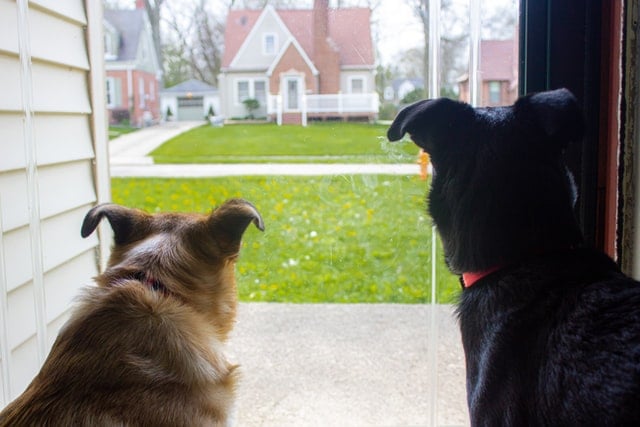No products in the cart.
A lot of people would agree that the past year has been stressful, with many forced to isolate for extended periods of time at home. One positive thing to emerge from the lockdowns has been a significant increase in dog adoptions, likely because having pets can help to alleviate feelings of stress and isolation. However, as a pet owner you must also accept responsibility for your animal’s mental health, so what happens if your dog exhibits signs of emotional distress? Below, we will go over the top 5 triggers & remedies for dog anxiety.
Symptoms of Dog Anxiety
As more people go back to work, their pets may experience stress once they start spending increased amounts of time alone. It is very important for owners to keep an eye out for any unusual behaviors or signs to indicate that their pet is feeling stressed, because the symptoms of anxiety can manifest in multiple ways.
Barking or Howling When Owner Isn’t Home
Oftentimes, dogs are very insecure about being separated from their owner, and will continually bark or howl the entire time they are left alone, which is a sign of dog anxiety. This can be a distressing thing for the whole neighborhood, so it’s good to check with your neighbors or get a camera to see if your dog has been barking while you are gone.

Destroying furniture / clothing
When dogs feel anxious, they will sometimes resort to destroying furniture by chewing off chair legs or door handles, in addition to shoes, clothes, toys, or anything else they can get a hold of. This issue can also arise if they were not properly trained as a puppy or get enough attention.
Panting and Pacing
If a dog is panting and pacing, it can be a major indicator that they are feeling very worried, scared, or agitated. One of the reasons why dogs have the urge to keep moving when they are stressed is because it can help to alleviate their restlessness.
Shivering
It is very sad and concerning to have a dog that cannot stop shaking. When a dog is shivering, regardless of the temperature, it is a signal that they are feeling very scared, stressed or experiencing “dog anxiety”.
Running Away / Cowering
If you see a lost dog wandering outside and you try to catch it, you may find it difficult because they tend to run away and cower when they feel threatened or scared, even from their owner.
Digging
Some dog owners may have noticed that if they put their dog in the yard for extended periods of time, they will start digging holes in the ground, or even try to burrow out if there is a fence. This can be a sign that they are stressed or anxious, but it is important to note that dogs also like to dig holes when it’s hot so that they can lay in the dirt and cool down.

Self Harm, Licking or Chewing
A dog who has experienced chronic stress over long periods of time may start engaging in self-mutilation, which can take the form of excessive licking or chewing on certain parts of the body, such as their feet or flanks. They may also compulsively chase and bite their tail, to the point of bleeding. Suffering from things like fleas or allergies can also induce this condition.
Urinating / Defecating
Like humans, stress can sometimes affect a dog’s bodily functions. This may result in things like excessive sweating, or uncontrollable bathroom urges. A lot of people experience stomach issues when they are stressed out, and dogs are no different. Excessive urinating or defecating in the house is a way for them to let you know that something is wrong.
Aggressiveness
If a dog is unusually aggressive or presenting a danger to others, it is typically the result of poor training or even abuse. Some dogs will lash out when they are feeling threatened or scared, but with a lot of care and work, most can be rehabilitated once they learn to be less fearful and more trusting.
Depression
When dogs are sad, they can also experience depression. If a dog appears to be listless, lacking energy, or sleeping too much, these can also be indications that the dog has depression.
5 Triggers of Dog Anxiety
The 5 triggers of dog anxiety involve factors that can also trigger humans as well. Our dogs actually have many of the same emotional reactions that we do when we are triggered, but aside from howling, barking, or growling, they have no way of verbally communicating to us what is bothering them. Here are some of the reasons that might explain why your dog is exhibiting symptoms of anxiety.
Fear of Being Alone / Abandonment
Like humans, dogs are very social creatures, and being isolated can have a grave emotional effect on them. Dogs experience separation anxiety because in their mind, they can never be sure whether you are actually going to come back. This makes them feel very anxious, and in some cases, even panicked.

Strangers
Many dogs will bark or react uncontrollably when confronted with a stranger, such as a delivery person or a friend that they have not previously come into contact with. Even the sound of the doorbell can trigger some dogs and cause them to bark, because they know it means a potential stranger is there.
Neglect and Abuse
A dog who has been neglected or abused will likely display many symptoms of dog anxiety, because of the trauma that they have experienced. It requires extreme care, training, and patience to help dogs who have been victimized to lose their fear and regain confidence.
Loud Noises
Oftentimes, victims of abuse or soldiers who have served in combat develop PTSD, which can manifest through symptoms that include an extreme aversion to loud noises, such as fireworks or gunshots. These loud noises can also scare dogs and other pets as well which creates dog anxiety. When the noises are unexpected it can be even worse, and there is no way of explaining to a dog that the loud sounds aren’t dangerous, or that there are fireworks on the 4th of July. An overwhelming amount of dog owners have grown to depend on these bacon or peanut butter flavored oils to calm their dogs.
Aging
As dogs get older, they will start to experience conditions that are related to aging, such as chronic pain and arthritis. This can also be worsened if they are overweight, because any additional weight can place a lot of strain on their body, especially if they are a smaller breed.

5 Ways to Relieve Anxious Dogs
It can be very difficult to see your dog in distress and feel helpless about what you can do for them. Fortunately, there are some great natural remedies or methods and techniques that can help alleviate their stress, with 5 ways to relieve anxious dogs.These topics will specifically address the questions of “what can I give my dog for anxiety?” which we get asked a lot.
Exercise!
It is so important for people who may be considering the decision to adopt a dog that they understand how dogs require A LOT of exercise. A properly exercised dog will be healthier and less stressed in general. If you know you are going to be gone for a long period of time or have people over, it is a good idea to take your dog out for an extra long walk beforehand, with lots of play time, so they are more tired when they get back. This can help to really avoid any mishaps or anxious behavior.
Brushing and Grooming
Dogs typically loved to be brushed and groomed. Not only does it make them feel better and look nicer, but they also love the attention and the physical contact. Research has shown that when dogs and owners look into each other’s eyes, they both experience an increase in Oxytocin, which is also known as the “love hormone”. This hormone is also released in mothers and babies when they look at each other or nurse, as it helps to facilitate bonding.
Soothing Noises
In 2017, the University of Glasgow conducted research that demonstrated how listening to music can help ease the stress of kenneled dogs. The study found that classic music was initially effective, but the dogs would grow bored with it after a few days. The results also showed that soft rock and reggae were the most successful at bringing down the heart rate of the dogs, which indicates a lower stress level. While the study could not conclusively determine whether the music made them bark less, it did note that they seemed to bark more when the music was cessated.
SSRIs
If a dog is suffering from severe or debilitating anxiety, it is a good idea to seek assistance from a veterinarian so they can suggest the medications for anxiety in dogs. Sometimes they can also recommend relaxation techniques or over the counter products that are specifically designed for dogs, but if the problem persists, vets can prescribe Selective Serotonin Reuptake Inhibitors, known as SSRIs, such as fluoxetine or clomipramine. These types of medication are also commonly prescribed for depression and anxiety conditions in humans.
CAM
Many people look into Complementary and Alternative Medicine, or CAM to help ease their dog’s stress. This can involve the use of things like massage therapy or even acupuncture. There has also been a surge in interest for pet owners who are curious as to whether hemp extract or CBD can be helpful as hemp products for dogs continue to become increasingly more prevalent, and researchers are currently in the process of conducting studies that are designed to determine whether hemp contains any beneficial properties.
Anxiety Dog Treats
Another over the counter product that could be helpful to pet owners are anxiety dog treats mixed with hemp oil. It’s important to research what different options are available, because there are so many methods to choose from. Don’t be afraid to contact a company and ask questions about what ingredients they use, how they are sourced, and their manufacturing process. The more transparent the company is, the higher quality they are likely to be.

Conclusion
Our pets are our family, and we will do whatever it takes to ensure that they are happy, healthy, and well taken care of. As long as your pet feels that love and support from you, they will be able to overcome any external factors that may be causing them stress and anxiety.

